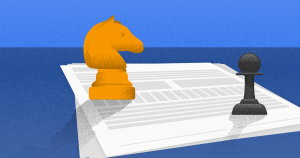If you’re creating content that does not engage the audience, it may be necessary to redefine your mindset. If you also have trouble creating successful campaigns and personalizing your strategies, something really important is probably missing: a clear vision of the process that takes people to buy something from your business.
In other words, if you’re facing that scenario, you need a customer journey map. This tool will allow you to understand the experience your prospects are having, leading your company to optimize results, which will increase conversion and sales.
Ready to know how this map works? Check it out!
What is a customer journey map?
A customer journey map is a graphical tool that helps you visualize the steps people take to get to your product and use it. It shows a set of phases from being aware that your company exists to becoming a fan and recurrent user of your product or service.
The tool is based on the fact that every buyer goes through a unique process before finding a clear solution to a problem. In a digital world, many cases follow the below sequence of events:
- searching for something on Google;
- finding a website;
- signing up for something and becoming a lead.
After these first 3 steps, the customer might purchase the product or service. However, this whole process includes a lot of interactions, which you will only know if you map them.
To go further, let’s consider a traditional map: it’s all about guiding people when they want to go from point A to point B, establishing all possible routes. It tells you how far you need to walk or drive to get to a certain location by showing you exactly how far you are.
A journey map works the same way but is applied to a marketing context.
The customer journey map demonstrates the stages people go through before buying something, capturing every single moment and highlighting those important decisions they make to go from point A to point B: from visiting a website one more time to signing up for a newsletter to get additional info.
That means a map is a way of understanding prospects better.
We do need a map because the customer journey can be tricky, with different steps and a non-linear structure. It all depends on the customer’s profile.
Nowadays, consumers decide to start a conversation or not with brands, and they keep the relationship going only if they want. Regardless, every business needs to know what guides prospective customers towards the buying decision.
The representation will expose if your company provides a great experience in each stage, which will help your business plotting effective strategies to do so. It will also reveal how well you’re leading prospects from one point to another.
When you don’t have a map, people can still get to your product or service by chance. Some of them even visit your website, sign up to become a lead, but then leave. In such situation, you don’t get to know why these visitors had interrupted their journey.
You are also unable to understand what to do in order to increase conversion rates and generate revenue. However, once you’ve mapped out the journey, everything changes.
Why is the customer journey map important?
We’ve already established what a customer journey map is. Now, let’s dive into what makes this tool so important for brands.
Visualization
One key aspect is visualization. With a map, your team will be able to see every phase prospects go through, which allows a better understanding of how they behave. Therefore, the tool will show what you’re doing to create a good experience.
Being able to see the stages of the customer journey is important because it helps clear your vision and focus on what’s actually happening: what you are doing and what you aren’t. Then the team can work on improving the strategies.
Conversion
A map will help your team members discuss better ideas for approaching every stage of the process, which will drive the company to increase conversion rates.
Think about it: once you’ve tracked the buyers’ journey, you can understand them better and then sell value with great strategies and convert them into leads.
As for content marketing, for instance: if the members know the steps users go through, they can create personalized content for each phase, meeting their needs in every specific moment.
If a visitor lands on a website and reads something that matches his interests — it may be an article that links to a webinar or an interactive e-book —, he will certainly trust the brand and move forward to become a lead.
In other words, mapping the journey helps with driving leads, increasing their quality, as well as reducing the cost per lead.
Alignment
With a customer journey map, you will also improve the alignment of your teams. That means marketing and sales can speak the same language and prepare together new strategies to enhance the customer experience in each phase.
A graphical tool helps everyone visualize the same thing, which is important to break down communication obstacles.
Engagement
Nowadays, it’s challenging to create content and marketing strategies that actually engage people. Sometimes, they are aware of the brand and have visited the website, but do not engage.
When a company tracks the customer’s journey, its members can create pieces of content that are engaging and surprising.
Indeed, you know the buyers so well that you can focus on what drives them to go to the next stage. You also know what to avoid in order to prevent them from leaving.
The marketing team can do that by creating interactive content tailored to the preferences of your prospects. That means getting them to actively engage and participate while reading some material.
Education
By mapping the phases your prospects move through, the business will be able to educate them better because of their needs, problems, and ambitions are well known.
That knowledge will help the team produce content that teaches them more about the solution they’re looking for.
Along with education, we have connections and engagement. If your content is valuable, the prospects will realize that your business has a solution and then will feel free to keep a long relationship. Also, they will get ready for a buying decision even before contacting a salesperson.
What components does a customer journey map include?
The answer to this question depends on the map. However, in general, the map contains a lot of information about the buyers, steps, strategies and so on. Four features are more significant, though: phases, persona, touchpoints, and channels.
Phases
As we already mentioned, the phases define the steps your buyer goes through, which can be:
- awareness stage: when they get to know the brand for the first time;
- consideration: when they are considering which solution is the best one;
- decision: when they know what the best solution is and are then moving forward to find a specific product or service.
Persona
The persona is a representation of the ideal customer. It’s important to have a persona because the map must be based on the customers’ perspective, considering their pain points, needs and feelings. Creating a persona-oriented tool will help you visualize what’s valuable to them, which will be essential to optimize their experience.
Touchpoints
It’s also necessary to include touchpoints, which are the key moments when prospects interact with your company. Those moments are crucial because you must show customers that their experience is a priority.
Touchpoints can be a product description page, for example, or even a form. It’s important to identify all the touchpoints and outline them on the map.
Channels
Channels allow the brand to communicate with audience. Social media, for instance, is an example of channel. People spend a long time checking timelines and publishing new content everyday.
Usually, they have conversations and interactions with brands that can lead them to a buying decision.
Then, all channels need to be included on the map. Other examples of channels are websites, e-mail, chats, and call centers.
How to create a customer journey map?
We’ve already described a customer journey map and talked about how important it is to create one. But how exactly do you create such a map? We are going to break this down next.
Initially, to get a better sense of the journey, you have to collect a lot of data. We’re talking about much more than a simple “what brought you here” question. You have to ask people deep and complete questions about every step of the process.
Set clear objectives for the map
First off, define your goals. What do you want to achieve with the map? Every person involved needs to be on the same page. You must set a target to hit so your team members can work towards that.
Establishing that common target reduces needless efforts, saves time and helps people prioritize what’s important.
So, before you get started, make sure you’ve evaluated your needs and set the goals. Ahead of this, the team can work on the next steps. With the results in mind, you can adjust whatever is wrong to match your objectives.
Profile your buyer persona
As we’ve already discussed, a persona is a semi-fictitious representation of your customer. If the point is to design a map, you have to profile your persona. That means conducting research with your existing customers to understand who they are, what they fear, which are their ambitions and needs, as well as what drove them to your company.
Being specific in the questions is important because it will help you gather enough information to know the prospects better and fill out the map with strategies to improve their experience.
The information can be demographic or psychographic (such as habits and values).
List all the buyer touchpoints
After defining the goals and persona, it’s time to identify the touchpoints. List all of them, in each stage, taking into account the different channels.
Identify customers’ pain points
The pain points are problems your prospects face throughout the journey. It’s important to visualize all of them because you have to address a resolution for them with the content.
Thus, you can talk to your prospects about solutions and educate them concerning your product or service.
Prioritize and take roadblocks out
Since we’re talking about a map, we have to think of roadblocks. A roadblock can make your prospect abandon your brand before the decision, thereby decreasing conversion rates.
So those obstacles are not welcome and have to be taken out as soon as possible in order to create a smooth and uninterrupted experience for the prospective client.
Update and improve the map with necessary changes
After you’ve come all this way, your team may need to change some details on the map in order to achieve your goals.
Sometimes the representation is not specific enough or does not capture the process perfectly. It’s important to monitor everything and make necessary improvements in the method to get a better knowledge of the journey.
How to visualize your customer journey map?
There are different ways of visualizing a journey map. You can represent it as a diagram on a whiteboard, using squares for each step and writing down the marketing strategies. Also, you can use Excel spreadsheets.
Depending on the level of granularity and established goal, we have different maps: one for a current state, another for the future state, and one for a day in prospect’s life.
The current state map outlines a set of stages, actions from the company, touchpoints, and experiences. It’s a traditional, widely-used type of map that shows the phases and the strategies to get people moving forward.
On the other hand, the future state describes what you want the prospect to do in each step. Lastly, the “a day in the life” model presents what prospects feel and think throughout a whole day. Thus, you can get to know the feelings, frustrations and pain points that are daily experienced.
The customer journey map helps you broaden your vision to meet the needs, pain points and goals of your customer. Therefore, your company can have a better understanding of who prospects are and how they move through different phases to reach the final solution.As a result, the marketing team can prepare effective actions for each phase of the customer journey.
Do you want to learn more about this subject? Make sure to check out other articles on our blog!








